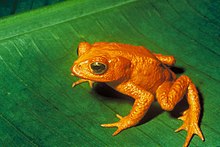Incilius
| Incilius Temporal range:
| |
|---|---|

| |
| A golden toad, the only species of toad in the Incilius genus that is extinct | |
| Scientific classification | |
| Domain: | Eukaryota |
| Kingdom: | Animalia |
| Phylum: | Chordata |
| Class: | Amphibia |
| Order: | Anura |
| Family: | Bufonidae |
| Genus: | Incilius Cope, 1863 |
| Type species | |
| Bufo coniferus (Cope, 1862)
| |
| Synonyms[1] | |
| |
Incilius is a genus of toads in the true toad family,
Taxonomy and systematics
This genus was first described in 1863 by Edward Drinker Cope who designated the type species as Incilius coniferus. This proved unpopular and these toads were known under the genus Bufo until the early 2000s.[1]
The current delineation of the genus follows Mendelson et al. (2011) who brought Cranopsis/Cranophryne/Ollotis and Crepidius/Crepidophryne into
Another discussion has been the taxonomic level at which the genus is recognized. Incilius did not see wide recognition before the large-scale revision of amphibian systematics by
Species
There are at present 39 species:[1]
- Incilius alvarius(Girard, 1859)
- Incilius aucoinae (O'Neill and Mendelson, 2004)
- Incilius aurarius Mendelson, Mulcahy, Snell, Acevedo, and Campbell, 2012
- Incilius bocourti (Brocchi, 1877)
- Incilius campbelli (Mendelson, 1994)
- Incilius canaliferus (Cope, 1877)
- Incilius cavifrons(Firschein, 1950)
- Incilius chompipe (Vaughan and Mendelson, 2007)
- Incilius coccifer (Cope, 1866)
- Incilius coniferus (Cope, 1862)
- Incilius cristatus (Wiegmann, 1833)
- Incilius cycladen (Lynch and Smith, 1966)
- Incilius epioticus (Cope, 1875)
- Incilius fastidiosus (Cope, 1875)
- Incilius gemmifer(Taylor, 1940)
- Incilius guanacaste (Vaughan and Mendelson, 2007)
- Incilius holdridgei(Taylor, 1952)
- Incilius ibarrai (Stuart, 1954)
- Incilius karenlipsae Mendelson and Mulcahy, 2010
- Incilius leucomyos (McCranie and Wilson, 2000)
- Incilius luetkenii (Boulenger, 1891)
- Incilius macrocristatus (Firschein and Smith, 1957)
- Incilius majordomus Savage, Ugarte, and Donnelly, 2013
- Incilius marmoreus (Wiegmann, 1833)
- Incilius mazatlanensis (Taylor, 1940)
- Incilius mccoyi Santos-Barrera and Flores-Villela, 2011
- Incilius melanochlorus (Cope, 1877)
- Incilius nebulifer (Girard, 1854)
- Incilius occidentalis(Camerano, 1879)
- †Incilius periglenes(Savage, 1967)
- Incilius peripatetes(Savage, 1972)
- Incilius perplexus (Taylor, 1943)
- Incilius pisinnus (Mendelson, Williams, Sheil, and Mulcahy, 2005)
- Incilius porteri (Mendelson, Williams, Sheil, and Mulcahy, 2005)
- Incilius signifer (Mendelson, Williams, Sheil, and Mulcahy, 2005)
- Incilius spiculatus (Mendelson, 1997)
- Incilius tacanensis (Smith, 1952)
- Incilius tutelarius (Mendelson, 1997)
- Incilius valliceps(Wiegmann, 1833)
The AmphibiaWeb recognizes Incilius intermedius (Günther, 1858) as a valid species,
One fossil species, Incilius praevius (Tihen, 1951), is known from the Early Miocene (Hemingfordian) of Florida.[8]
References
- ^ a b c d e f g h Frost, Darrel R. (2017). "Incilius Cope, 1863". Amphibian Species of the World: an Online Reference. Version 6.0. American Museum of Natural History. Retrieved 4 July 2017.
- ^ a b "Bufonidae". AmphibiaWeb: Information on amphibian biology and conservation. [web application]. Berkeley, California: AmphibiaWeb. 2017. Retrieved 4 July 2017.
- ^ Vitt, Laurie J.; Caldwell, Janalee P. (2014). Herpetology: An Introductory Biology of Amphibians and Reptiles (4th ed.). Academic Press. p. 490.
- .
- . Retrieved 4 September 2019.
- hdl:2246/5781.
- S2CID 283839.
- ^ Sanchiz, B. (2012-01-01). "Nomenclatural notes on living and fossil amphibians". Graellsia.
